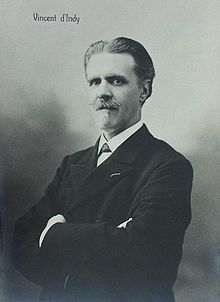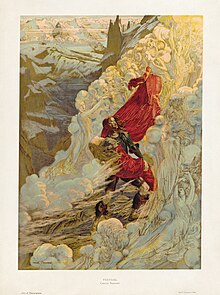Vincent d'Indy

Paul Marie Théodore Vincent d'Indy (French:
D'Indy studied under composer César Franck, and was strongly influenced by Franck's admiration for German music. At a time when nationalist feelings were high in both countries (circa the Franco-Prussian War of 1871), this brought Franck into conflict with other musicians who wished to separate French music from German influence.
Life
Paul Marie Théodore Vincent d'Indy was born in Paris into an aristocratic family of
From the age of 14 d'Indy studied harmony with Albert Lavignac. When he was 16 an uncle introduced him to Berlioz's treatise on orchestration, which inspired him to become a composer.[2] He wrote a piano quartet which he sent to César Franck, who was the teacher of a friend. Franck recognised his talent and recommended that d'Indy pursue a career as a composer.[2]
At the age of 19, during the

The first of his works he heard performed was a Symphonie italienne, at an orchestral rehearsal under Jules Pasdeloup; the work was admired by Georges Bizet and Jules Massenet, with whom he had already become acquainted.[1]
During the summer of 1873 he visited Germany, where he met Franz Liszt and Johannes Brahms. On 25 January 1874, his overture Les Piccolomini was performed at a Pasdeloup concert, sandwiched between works by Bach and Beethoven.[1] Around this time he married Isabelle de Pampelonne, one of his cousins. In 1875 his symphony dedicated to János Hunyadi was performed. That same year he played a minor role – the prompter – at the premiere of Bizet's opera Carmen.[1] In 1876 he was present at the first production of Richard Wagner's Ring cycle at Bayreuth. This made a great impression on him and he became a fervent Wagnerian.[3]
In 1878 d'Indy's symphonic ballad La Forêt enchantée was performed.[4] In 1882 he heard Wagner's Parsifal. In 1883 his choral work Le Chant de la cloche appeared. In 1884 his symphonic poem Saugefleurie was premiered. His piano suite ("symphonic poem for piano") called Poème des montagnes came from around this time. In 1887 appeared his Suite in D for trumpet, 2 flutes and string quartet. That same year he was involved in Lamoureux's production of Wagner's Lohengrin as choirmaster. His music drama Fervaal occupied him between 1889 and 1895.[3]

Inspired by his studies with Franck and yet dissatisfied with the standard of teaching at the Conservatoire, d'Indy, together with Charles Bordes and Alexandre Guilmant, founded the Schola Cantorum de Paris in 1894.[3] D'Indy taught there until his death, becoming principal in 1904.[3] Of the teaching at the Schola Cantorum, The Oxford Companion to Music says, "A solid grounding in technique was encouraged, rather than originality", and comments that few graduates could stand comparison with the best Conservatoire students.[5] D'Indy later taught at the Conservatoire and privately, while retaining his post at the Schola Cantorum.[3]
Among d'Indy's renowned pupils were
D'Indy played an important part in the history of the
According to the biographer
During the
D'Indy died on 2 December 1931 in his native Paris, aged 80, and was buried in the Montparnasse Cemetery.[11]
Works
Few of d'Indy's works are performed regularly in concert halls today. Grove comments that his famed veneration for Beethoven and Franck "has unfortunately obscured the individual character of his own compositions, particularly his fine orchestral pieces descriptive of southern France".[3] Among his best known pieces are the Symphony on a French Mountain Air for piano and orchestra (1886), and Istar (1896), a symphonic poem in the form of a set of variations in which the theme appears only at the end.[1]

Among d'Indy's other works are more orchestral pieces, including a Symphony in B♭, a vast symphonic poem, Jour d'été à la montagne, and another, Souvenirs, written on the death of his first wife. The Times said of his music that the influence of Berlioz, Franck, and Wagner is strong in almost all his work, "that of Franck showing itself chiefly in the shapes of his tunes, that of Wagner in their development, and that of Berlioz in their orchestration".[2]
Grove says of his chamber works: "D'Indy's somewhat academic corpus of chamber music (including three completed string quartets) is generally less interesting than his orchestral works". He also wrote piano music (including a Sonata in E minor), songs and a number of operas, including
D'Indy helped revive a number of then largely forgotten Baroque works, for example making his own edition of
Commemorations
The private music college
Notes, references and sources
Notes
- ^ Other students included Pierre Capdevielle, Léon Destroismaisons, Déodat de Séverac, Eugène Lapierre, Leevi Madetoja, Rodolphe Mathieu, Helena Munktell, Ahmet Adnan Saygun, Anne Terrier Laffaille, Emiliana de Zubeldia and Xian Xinghai.
References
- ^ Grove's Dictionary of Music and Musicians, 5th edition, 1954, volume V, Eric Blomed.
- ^ a b c d e f "M. Vincent d'Indy", The Times, 4 December 1931, p. 16
- ^ a b c d e f g h i j k l m n Orledge, Robert, and Andrew Thomson. "Indy, (Paul Marie Théodore) Vincent d'", Grove Music Online, Oxford University Press, 2001 (subscription required)
- ^ "Courrier des théâtres", Le Figaro, 22 March 1878, p. 3
- ^ "Schola Cantorum", The Oxford Companion to Music, edited by Alison Latham, Oxford University Press, 2011.
- )
- ^ McBrien, p 94; and Citron, p. 56
- ^ Templier, p. 32
- ^ a b c Cochard, Alain. "150ème anniversaire de la naissance de la Société nationale de musique", Concertclassic.com. Retrieved 13 May 2021
- ^ a b Duchesneau, Michel. "Maurice Ravel et la Société Musicale Indépendante: 'Projet Mirifique de Concerts Scandaleux'", Revue de Musicologie, vol. 80, no. 2, 1994, pp. 251–281 (subscription required); and "La musique française pendant la Guerre 1914–1918: Autour de la tentative de fusion de la Société Nationale de Musique et de la Société Musicale Indépendante", Revue de Musicologie, 1996, T. 82, No. 1, p. 148 (subscription required)
- ^ "Les obsèques de Vincent d'Indy", Comoedia, 5 December 1931, p. 2
- OCLC 1114800864, retrieved 18 July 2022
- ^ "Historique", École de musique Vincent-d'Indy, 2021. Retrieved 15 May 2021
- ^ "(11530) d'Indy", International Astronomical Union Minor Planet Center. Retrieved 15 May 2021
Sources
- Blom, Eric (1954). Grove's Dictionary of Music and Musicians (fifth ed.). New York: St Martin's Press. OCLC 1192249.
- Citron, Stephen (1993). Noël and Cole: The Sophisticates. New York: Oxford University Press. ISBN 978-0-19-508385-9.
- McBrien, William (1998). Cole Porter. New York: Knopf. OCLC 1148597196.
- Templier, Pierre-Daniel (1969). Erik Satie. Cambridge, Mass: MIT Press. OCLC 1034659768.
Further reading
- Norman Demuth, Vincent d'Indy: Champion of Classicism (London, 1951)
- Steven Huebner, Vincent d'Indy and Moral Order' and 'Fervaal': French Opera at the Fin de Siècle (Oxford, 1999), pp. 301–08 and 317–50
- Vincent d'Indy (Marie d'Indy, ed.), Vincent d'Indy: Ma Vie. Journal de jeunesse. Correspondance familiale et intime, 1851–1931 (Paris, 2001). ISBN 2-84049-240-7
- James Ross, 'D'Indy's "Fervaal": Reconstructing French Identity at the Fin-de-Siècle', Music and Letters 84/2 (May 2003), pp. 209–40
- ISBN 2-87009-888-X
- Andrew Thomson, Vincent d'Indy and his World (Oxford, 1996)
- Robert Trumble, Vincent d'Indy: His Greatness and Integrity (Melbourne, 1994)
- Huebner, Steven (2006). French Opera at the Fin de Siècle: Vincent d'Indy. Oxford Univ. Press, US. pp. 301–350. ISBN 978-0-19-518954-4.
External links
- Works by or about Vincent d'Indy at Internet Archive
- D'Indy Trio for Clarinet, Cello & Piano, Op. 29, Piano Quartet Op. 7, String Quartet No. 1 and String Sextet, Op. 92 soundbites and discussion of works
- Free scores by Vincent d'Indy at the International Music Score Library Project (IMSLP)
- Free scores by Vincent d'Indy in the Choral Public Domain Library (ChoralWiki)
- Performance of Lied for cello and orchestra on
